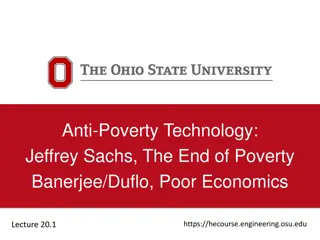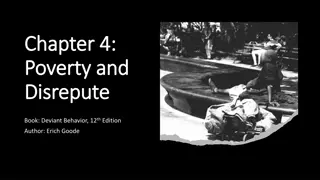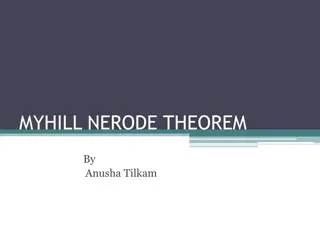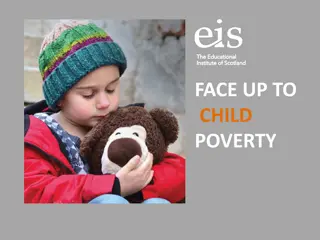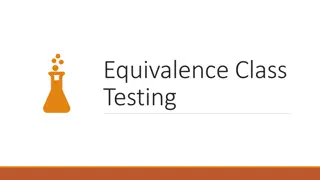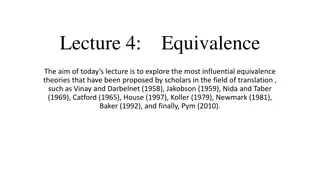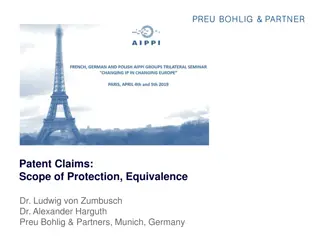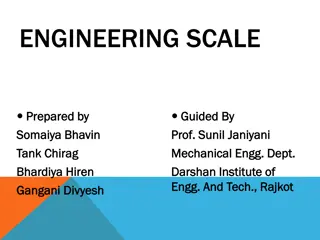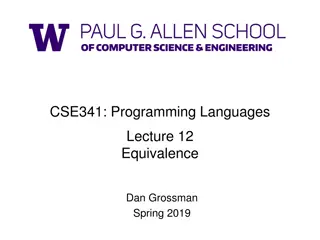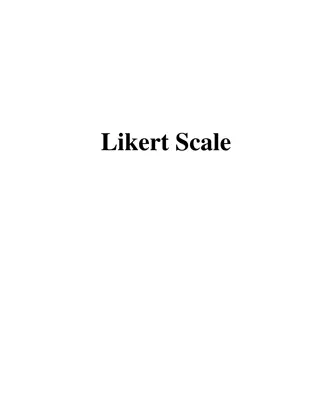The Important Role of Equivalence Scales in Poverty Dynamics
Equivalence scales play a crucial role in measuring household welfare and poverty dynamics in Russia. This study explores the impact of adjusting scales on poverty lines, chronic poverty, and income mobility using subjective well-being data. The findings reveal higher elasticity for adding adults to households, leading to lower estimated poverty lines and significant effects on chronic poverty and income mobility. The study's robustness is ensured through various checks.
Download Presentation

Please find below an Image/Link to download the presentation.
The content on the website is provided AS IS for your information and personal use only. It may not be sold, licensed, or shared on other websites without obtaining consent from the author.If you encounter any issues during the download, it is possible that the publisher has removed the file from their server.
You are allowed to download the files provided on this website for personal or commercial use, subject to the condition that they are used lawfully. All files are the property of their respective owners.
The content on the website is provided AS IS for your information and personal use only. It may not be sold, licensed, or shared on other websites without obtaining consent from the author.
E N D
Presentation Transcript
The Important Role of Equivalence Scales: Household Size, Composition, and Poverty Dynamics in Russia Kseniya Abanokova, Hai-Anh H. Dang and Michael M. Lokshin ****************** Special IARIW-HSE Conference Moscow September 17-18, 2019
Outline 1. 2. 3. 4. Motivation & Contribution Main Findings Literature Review Empirical Strategy a) Measuring Scale Elasticity b) Measuring Chronic Poverty & Income Mobility Data Description Estimation results a) Scale Parameters & Adjusted Poverty Lines b) Scale Factors & Poverty c) Scale Factors & Income Mobility d) Robustness Checks & Further Extensions Conclusion 5. 6. 7.
Motivation and Contribution Comparable measure of incomes across households of different sizes and compositions is a crucial task for poverty measurements (Lanjouw and Ravallion, 1995; Peichl et al., 2012; Bishopet al.,2014) Several contributions: 1. Equivalence scales are estimated using subjective well-being data Better capture household welfare than satisfaction data (Ravallion and Lokshin, 2001 & 2002) Only one study used subjective well-being panel data for Russia (Ravallion and Lokshin, 2002) 2. Effect of scale adjustment on poverty dynamic Important for poverty reducing policy Previous studies used static poverty measurements (Newhouse et al., 2017) 3. Effect of scale adjustment on income dynamic To what extent income mobility can be affected by scale adjustments (Dang et al., forthcoming) 4. Long-run panel data is used Better capture demographic changes and allow to include multigenerational households 5. Important analysis for Russia Previous studies were based on countries that have different demographic structure than in Russia New poverty lines
Main findings In equivalence scales terms: elasticity is higher for adding another adult to a two-adult household than a child Scaling results in lower estimates of poverty lines: country s official poverty threshold ranges from 50% to more than 200% higher than our estimated poverty lines Chronic poverty is sensitive to scaling, but less sensitive to the child scale factor than to the adult scale factor Income mobility also significantly depends on scaling and can be classified as either upward or downward with different scale parameters Our results are robust to different robustness checks
Studies estimated subjective scales from panel data Weight given to the additional household member Author Data Welfare indicator Subsample Specification 2nd adult (1st adult = 1) 0,5 0,43 0,5 0,34 0,28 0,43 0,43 0,48 0,07 1st child (in 2/1 adult hh) 0.23/0.34 0.20/0.28 0.26/0.39 0.17/0.30 0.13/0.24 0.25/0.39 0.26/0.4 0.28/0.43 0.09/0.1 2nd child (in 2/1 adult hh) 0.15/0.23 0.10/0.16 0.19/0.28 0.08/0.14 0.06/0.11 0.14/0.22 0.15/0.23 0.14/0.24 0.11/0.11 Pooled ordered logit FE ordered logit (Das and van Soest (1999) approach) RE ordered logit Pooled ordered logit FE binary logit OLS Orderel probit FE linear model FE linear model Satisfaction with life/ Satisfaction with hh income Charlier (2002)* Sample of household heads GSOEP, 1984 91 Respondents who answered at least twice are included Schwarze (2003) Satisfaction with hh income GSOEP, 1992 99 Satisfaction with hh income Households who answered at least twice are included Falter (2006)** SHP, 1999-2002 Minimum Income Question Individuals 18-80 yo who are household heads or the partner of the head with or without minor children FE ordered logit (Baetschmann et al. (2015) approach), men 0,15 1.12/1.64 0.68/1.22 Self-assessed financial situation Bollinger et al.(2012) BHPS, 1991-2008 FE ordered logit (Baetschmann et al. (2015) approach), women 0,31 1.17/1.52 0.41/0.78 Individuals 17 yo living in households with less than 6 members Biewen and Juhasz (2017)*** Nonlinear FE ordered logit (based on Baetschmann et al. (2015)) GSOEP, 1999 2009 Satisfaction with hh income 0,35 0,13 0,13 0.18-0.29/ 0.29-0.37 0.12-0.31 0.16-0.13/ 0.24-0.17 0.10-0.27/ 0.16-0.30 0.12-0.31 0.10-0.12/ 0.15-0.14 Pooled ordered logit 0.31-0.36 Individuals 18 yo, one- or two-adult-households with or without minor children Nonlinear least squares Borah et al. (2018)**** GSOEP, 1984-2013 Satisfaction with hh income 0.31-0.25 FE ordered logit (Baetschmann et al. (2015) approach) 0.26-0.15
Empirical Strategy 1. Measuring Scale Elasticity ??? ??? = ??? ? + ??? ??? + ??+ ??? Equation 1 ? Household s equivalence weight (?) that depends on number of adults (???) and children (???) ? ???,??? = (???+ ???) Schwarze (2003) Scale elasticity parameter (?) consists of baseline elasticity (??) and child elasticity (?) such that ? = ?? ???? Individual-level unobserved component and error-term Personal and household characteristics Total Individual i s latent utility household income = ??? ? + ?????? ????? ???+ ??? + ??????? ???+ ??? + ??+ ??? ??? Equation 2 Equivalence elasticity for household without children ??(=??? ?), when children are present ?(=?? ?)
Empirical Strategy 1. Measuring Scale Elasticity. Estimation as follows ??+1, We observe ??? which is related to ??? ??? = ? ?? ??< ??? ? = 1, ,9 where individual-specific thresholds ?? are increasing ??< ??+1 ??? ?1= ??? ??+1= The probability of observing outcome j for individual i at time t: ??? ?? ??? ?? ? ?1? ? ?1? Pr ???= ? ???,?(.),??) = ??+1 ??? ?? (?? ??? ??) ? ? where (.) - cumulative logistic distribution BUC ( Blow-Up and Cluster ) fixed-effects estimator We apply BUC ( Blow-Up and Cluster ) fixed-effects estimator developed by Baetschmann et al. (2015)
Empirical Strategy 2. Measuring Chronic Poverty and Income Mobility Measuring chronic poverty with Jalan and Ravallion`s decomposition intertemporal mean of poverty for each individual ??=1 ? ? ? ?(???< ?) 1 ??? where is a poverty aversion indicator, I(.) is the indicator function, ), ?? is average of all incomes of over the period ? ?=1 The aggregate chronic poverty index ? ? ??=1 1 ?? ? ? ??< ? ? ?=1 Measuring income mobility Unconditional mobility Upward unconditional mobility Conditional mobility Upward conditional mobility ??= ???+ ??? ??= ? ?? ?1 ??+1??? ?2 ??+1 ?? ??represent individuals income threshold k in year t ?= ?? ??+ ?? ?? ?? ??= ? ?2 ??+1|?? ?1 ??+1 ??
Data Description Russian Longitudinal Monitoring Survey (RLMS), unbalanced panel data set over the period 1994-2017 Estimation sample: individuals aged 16 years old or older living in hhs with <6 adults and <4 children Individuals are followed over time, not households (but we cluster by household-wave level) Income measure: total monetary household income (deflated and adjusted for regional differences) We remove 0.25% of income outliers
Sample distribution of subjective welfare variable, RLMS 1994-2017 Please imagine a nine-step ladder where on the bottom, the first step, stand the poorest people, and on the highest step, the ninth, stand the rich. On which step of the nine steps are you personally standing today? (1-9) Panel summary statistics: Within variation (28% of total variance)< between variation 23-24% on average were on 3th, 4th and 5th levels More than 40% of those ever on 3-5th levels were always on these levels and about 35% of those remained on 3-5th levels next period .25 .2 .15 Density .1 .05 0 1 2 3 4 5 6 7 8 9 Subjective welfare
Estimation Results 1. Scale parameters Dependent variable: subjective wealth Pooled Ordered Logit 0.636*** (0.03) 0.078*** (0.01) 0.636-0.078*k Scale parameters FE OLS 0.399*** (0.06) 0.050** (0.02) 0.399-0.050*k BUC 0.407*** (0.09) 0.048* (0.03) 0.407-0.048*k Baseline elasticity ??= ???/? Additional child ? = ??/? Overall elasticity ? Note: Standard errors in parentheses are calculated using delta-method. All regressions include age groups, education level, marital status, employment status, respondent`s poor health, dummy whether there are other household members in poor health, dummy indicating whether the person was employed at survey time and per capita living space and time effects as additional variables. Pooled model additionally includes gender, nationality and regional state effects. Main Results Overall elasticity is higher for adding another adult than a child to a two-adult household for all models Controlling for unobserved individual heterogeneity reduces by about one-third both the estimated equivalence scale parameter for adults and for children Full regression results
Estimation Results 2. Comparison of different equivalence scales Adult equivalent weights Child equivalence weight (first child) Child equivalence weights (second child) 100 90 Weight given to additional member (%) 80 70 60 50 40 30 20 10 0 2 3 4 5 1 2 3 4 5 2 3 4 Number of adults Number of adults Number of adults RUS Poverty Line Per capita Square-root Per capita RUS Poverty Line Square-root Per capita Square-root RUS Poverty Line BUC OECD modified BUC OECD modified OECD modified BUC
Estimation Results 3. Adjusted Poverty Lines in 2017 Absolute Poverty Line Pooled OL Households without children 9,607 9,607 14,891 12,777 19,310 14,987 23,153 17,004 26,707 18,542 Household with children 14,122 12,297 17,773 14,218 18,734 14,795 20,847 15,755 20,847 15,852 23,537 17,100 22,673 16,812 26,131 18,253 Relative Poverty Line Pooled OL Official Poverty Line Main Results Household Type BUC BUC 1. Absolute Poverty Line: Official poverty line ranges from 50% to 160% higher for hhs without any children; Official poverty line ranges from 160% to more than 200% higher for hhs with children; One adult, no children Two adults, no children Three adults, no children Four adults, no children Five adults, no children 10,800 13,913 15,931 17,520 17,397 10,800 16,306 20,488 24,066 25,150 9,607 19,214 28,821 38,428 48,035 One adult, one child Two adults, one child Two adults, two children Three adults, one child Three adults, two children Four adults, one child Four adults, two children Five adults, one child 12,226 14,973 15,422 15,225 18,885 20,098 20,311 20,201 14,035 18,632 19,493 20,062 24,788 27,685 27,494 28,855 19,532 29,139 39,064 38,746 48,671 48,353 58,278 57,960 2. Relative Poverty Line: Official poverty line ranges from 20% to 90% higher for hhs without any children; Official poverty line ranges from 40% to 100% higher for hhs with children;
Estimation Results 4. Scale Factors & Headcount Poverty Rate in 2017 Main Results: 1. Absolute Poverty Line Poverty rate can decrease by 9 to 15 p.p. if ?? decreases from 1 to 0.5; Poverty rate remains almost the same if ?? decreases from 0.5 to 0.1 2. Relative Poverty Line Poverty rate increases by at most 4 p.p. if ?? decreases from 1 to 0.5; Poverty rate increases by more than 4 p.p. if ?? decreases from 0.5 to 0.1 Poverty is less sensitive to the choice of the child discount factor
Estimation Results 5. Scale Factors & Poverty Duration Main Results Absolute Poverty Line: poverty duration ranges from 1.8 to 2.6 years Relative Poverty Line: poverty duration ranges from 2 to 2.7 years Poverty duration varies by less than 0.2 years for both the absolute and the relative poverty lines
Estimation Results 6. Scale Factors & Chronic Poverty Absolute Poverty Line ??=0.4 ??=0.5 Relative Poverty Line ??=0.3 Headcount Poverty 0.085 0.036 0.049 57.3 Poverty Gap 0.030 0.015 0.015 49.6 Squared Poverty Gap 0.016 0.009 0.007 45.6 ??=0.6 ??=0.7 ??=0.3??=0.4??=0.5??=0.6 ??=0.7 Total Poverty Transient Poverty Chronic Poverty Share of chronic poverty (%) 0.100 0.041 0.059 59.4 0.119 0.045 0.074 62.1 0.142 0.050 0.092 64.9 0.170 0.054 0.115 67.9 0.208 0.049 0.049 0.049 0.049 0.048 0.158 0.151 0.145 0.139 0.134 76.3 75.5 74.8 0.2 0.194 0.187 0.182 Chronic poverty is positively (with absolute poverty line) and inversely (with relative poverty line) related to the adult scale parameter, regardless of the poverty measures 74.1 73.7 Total Poverty Transient Poverty Chronic Poverty Share of chronic poverty (%) 0.035 0.017 0.018 50.7 0.042 0.020 0.022 52.3 0.050 0.023 0.027 54.5 0.060 0.026 0.035 57.2 0.068 0.065 0.062 0.059 0.058 0.024 0.023 0.023 0.023 0.023 0.045 0.041 0.039 0.036 0.035 65.6 64.2 63 61.8 60.9 Total Poverty Transient Poverty Chronic Poverty Share of chronic poverty (%) 0.019 0.010 0.009 46.1 0.022 0.012 0.010 47.1 0.026 0.014 0.013 48.5 0.032 0.016 0.016 50.5 0.034 0.031 0.014 0.014 0.014 0.013 0.013 0.02 0.018 0.017 0.016 0.015 58.2 56.4 55 0.03 0.029 0.029 53.7 52.8 Note: Relative poverty line is set on 60% of household size-weighted median equivalized income. Both the poverty thresholds and household income are converted to constant 2011 rubles using regional CPI indices provided by the Rosstat. The child scale parameter is set at 0.04.
Estimation Results 7. Scale Factors & Income Mobility
Estimation Results 7. Scale Factors & Income Mobility Selection of scale parameters can change estimation results for income dynamics Unconditional Mobility Conditional Mobility When ??= 1 (Per Capita) - there is always more upward unconditional mobility, for all values of the child parameter When ??= 0.5 (Square-Root) - there is always more downward conditional mobility, for all values of the child parameter
Robustness Checks and Further Extensions Alternative specifications on scale parameters estimates Alternative functional form Alternative measurements of chronic poverty
Conclusion In equivalence scales terms: elasticity is higher for adding another adult to a two-adult household than a child Scaling results in lower estimates of poverty lines: country s official poverty threshold ranges from 50% to more than 200% higher than our estimated poverty lines Chronic poverty is sensitive to scaling, but less sensitive to the child scale factor than to the adult scale factor Income mobility also significantly depends on scaling and can be classified as either upward or downward with different scale parameters Our results are robust to different robustness checks
How do the demographics differ by country? Panel A: Average household size Panel B: Single person 3.0 25 % of total population 2.5 20 2.0 15 1.5 Russia has the largest household size, which averages at least 2.6 persons per household 10 1.0 5 0.5 0.0 0 2008 2009 2010 2011 2012 2013 2014 2015 2016 2017 2008200920102011201220132014201520162017 Single-person households are also least common in Russia, accounting for less than 10 percent of the total population Germany United Kingdom Russia Switzerland Germany United Kingdom Russia Switzerland Panel C: Three or more adults 40.0 35.0 Percentage of all hhs Russia has the largest proportion of extended households 30.0 25.0 20.0 15.0 10.0 5.0 0.0 2008200920102011201220132014201520162017 Germany United Kingdom Russia Switzerland
Blow-Up and Cluster estimator (Baetschmann et al., 2015) 1. Recode dependent variable with j categories into J 1 different dichotomizations using J 1 different thresholds 2. Blowing up the data: every observation in the sample is replaced by J-1 copies of itself (one for each threshold or cut-off point) then dichotomizes every J 1 copy of the individual at all available cut-off points 3. Cluster the data: standard errors are adjusted for clustering as some individuals contribute to several terms in the log-likelihood function 4. Apply conditional maximum likelihood estimation for every possible threshold at each point in time for each individual in the data Parallel regression assumption: estimates for (?, ?) are equal across all dichotomizations
Detailed regression results Variables Pooled OL 0.655*** (0.011) -0.417*** (0.023) 0.051*** (0.008) 1.027*** (0.031) 0.386*** (0.021) 0.188*** (0.019) -0.092*** (0.019) -0.009 (0.025) 0.103*** (0.028) 0.399*** (0.038) -0.027* (0.014) -0.262*** (0.024) 0.193*** (0.019) 0.298*** (0.021) 0.446*** (0.023) -0.260*** (0.023) -0.333*** (0.019) -0.275*** (0.015) -0.136*** (0.010) -0.075*** (0.011) 0.000 (0.002) 237,395 -403,224 42,326 0.043 FE OLS 0.249*** (0.007) -0.100*** (0.016) 0.012** (0.005) 0.404*** (0.029) 0.178*** (0.021) 0.062*** (0.014) -0.004 (0.013) 0.057*** (0.019) 0.094*** (0.023) 0.330*** (0.030) -0.010 (0.012) -0.043*** (0.016) -0.004 (0.022) -0.029* (0.017) -0.156*** (0.013) -0.162*** (0.009) -0.047*** (0.006) -0.013* (0.007) 0.001 (0.001) 240,640 -346,509 42,894 0.036 BUC 0.412*** (0.079) -0.167*** (0.034) 0.020* (0.010) 0.668*** (0.077) 0.296*** (0.057) 0.101*** (0.036) -0.006 (0.039) 0.097 (0.065) 0.159* (0.083) 0.542*** (0.086) -0.014 (0.041) -0.071 (0.056) 0.003 (0.082) -0.048 (0.037) -0.263*** (0.040) -0.269*** (0.030) -0.080*** (0.012) -0.022* (0.012) 0.002 (0.002) 712,448 -263,848 30,058 0.0285 Ln household income (?) Ln household size ( ???) Children# Ln household size (??) Age 16-20 Age 21-30 Age 31-40 Age 51-60 Age 61-70 Age 71-80 Age 80+ Female Russian nationality Complete secondary Secondary + vocational University and higher Single Divorced/widowed/separated Unemployed/out of labor force Bad health Other members with bad health Log of per capita living space Number of observations Log pseudolikelihood Number of individuals Pseudo-R squared
Robustness Checks The effect of alternative specifications on scales Pooled OL BUC Sensitivity scenarios Baseline elasticity 0.649*** (0.03) 0.497*** (0.06) 0.762*** (0.03) 0.571*** (0.04) 0.577*** (0.03) 0.560*** (0.04) Additional child 0.080*** (0.01) 0.057* (0.02) 0.117*** (0.01) 0.089*** (0.01) 0.020* (0.01) 0.064*** (0.01) Additional child 0.050* (0.03) Baseline elasticity 0.410*** (0.09) 0.659*** (0.11) 0.342*** (0.10) 0.306*** (0.09) 0.352* (0.15) 1 Expectations 2 Reference group 0.043* (0.03) 0.056* (0.03) -0.013 (0.02) 0.046* (0.03) 3 Life satisfaction 4 Measurement error 5 Unrestricted sample 6 Pensioners
Robustness Checks Alternative functional form ??? ?? ??? Non-parametrical function proposed by Biewen and Juhasz (2017) ? = ?? ? ) ?(???+ ??? ? ??? ? ???+ ??? = 1 ???1???0 + ??2?? ???2???0 + ??2?1 ???2???1 + + ??5?1 ???5???1 Results for non-parametric scales Parameter One adult, one child Two adults, no child Two adults, one child Two adults, two children Three adults, no child Three adults, one child Four adults, no child Four adults, one child Five adults, no child Five adults, one child Number of observations Log pseudolikelihood Coefficient 1.422*** 1.243*** 1.374*** 1.259*** 1.454*** 1.704*** 1.731*** 1.836*** 1.968*** 1.836*** Std.Error (0.23) (0.11) (0.15) (0.16) (0.14) (0.19) (0.20) (0.24) (0.31) (0.33) Equivalence weight of a second adult is 24% of the first adult Equivalence weight of first child is 13% for two-adult hhs, or about half of the second adult in one-adult hh 74,627 -237,360
Robustness Checks Scale Factors & Chronic Poverty (Foster`s index) Relative Poverty Line Absolute Poverty Line



